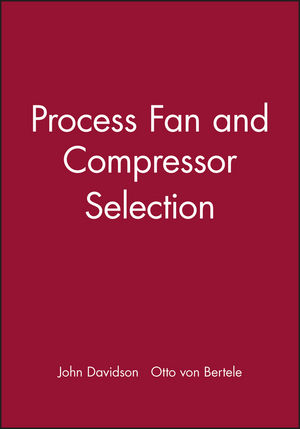Process Fan and Compressor SelectionISBN: 978-0-85298-825-1
Hardcover
240 pages
October 2005
 This is a Print-on-Demand title. It will be printed specifically to fill your order. Please allow an additional 10-15 days delivery time. The book is not returnable.
|
||||||
Preface.
Acknowledgements.
Biographical Notes.
Notation.
PART ONE. INTRODUCTION AND PRELIMINARY SELECTION.
Chapter 1. Introduction.
1.1 The Purpose of the Guide.
1.2 The Philosophy of Selection.
1.3 Design Procedure.
Chapter 2. Preliminary Choice of Fan o0r Compressor Type.
2.1 Introduction.
2.2 Establishing the Duty.
2.3 Preliminary Choice of Fan or Compressor Type.
2.4 Fan and Compressor Applications.
2.5 Provision of Installed Spares.
2.6 Estimate of Costs.
PART TWO. TOTO-DYNAMIC MACHINES.
Foreword to Roto-Dynamic Machines.
Chapter 3. Fans.
3.1 Introduction.
3.2 Basic Data.
3.3 Margins.
3.4 Design Point.
3.5 Factors Affecting Centrifugal Fan Selection.
3.6 Axial Fans.
3.7 Control.
3.8 Selecting a Fan.
3.9 Power.
3.10 Drivers.
3.11 Casing.
3.12 Ducting.
3.13 Materials.
3.14 Noise.
3.15 Example.
Chapter 4. Centrifugal Compressors.
4.1 Introduction.
4.2 Characteristic.
4.3 Establish Duties.
4.4 Compressor Configuration.
4.5 Essential Data.
4.6 Tip Speed.
4.7 Flow Coefficient.
4.8 Diameter and Shaft Speed.
4.9 Polytropic Index.
4.10 Total Head.
4.11 Pressure Coefficient.
4.12 Stage Head.
4.13 Number of Impellers/Casings.
4.14 Discharge Temperature.
4.15 Intercooling.
4.16 Discharge Volume.
4.17 Power.
4.18 Compressor Characteristic.
4.19 Anti-surge.
4.20 Rotating Stall.
4.21 Control.
4.22 Operation.
4.23 Rotor Dynamics.
4.24 Shafts.
4.25 Impellers.
4.26 Seals.
4.27 Bearings.
4.28 Axial Unbalance and Bearings.
4.29 Casings.
4.30 Vessels.
4.31 Instrumentation.
4.32 Safety and Availability.
4.33 Couplings.
4.34 Layout.
4.35 Drivers.
4.36 Example.
Chapter 5. Axial Compressors.
5.1 Introduction.
5.2 Characteristic.
5.3 Establish Duty.
5.4 Design of Axial Stage.
5.5 Essential Data.
5.6 Arrangement.
5.7 Sizing.
5.8 Control.
5.9 Surging.
5.10 Casing.
5.11 Overall Dimensions.
5.12 Drivers.
5.13 Example.
PART THREE. POSITIVE DISPLACEMENT MACHINES.
Chapter 6. Reciprocating Compressors.
6.1 Introduction.
6.2 General Description.
6.3 Basic Process Data.
6.4 Number of Compressors.
6.5 Basic Design.
6.6 Throughput Control.
6.7 Number of Stages—Control Included.
6.8 Configuration.
6.9 Mean Piston Speed.
6.10 Frame Size.
6.11 Cylinder Design.
6.12 Volumetric Efficiency.
6.13 Piston Diameter.
6.14 Number of Cylinder Per Stage.
6.15 Compressor Valves.
6.16 Bearings and Lubrication.
6.17 Piston and Rider Rings.
6.18 Piston Glands.
6.19 Crankcase.
6.20 Materials.
6.21 Vessels.
6.22 Instrumentation.
6.23 Layout.
6.24 Noise.
6.25 Safety.
6.26 Drivers.
6.27 Other Considerations.
6.28 Operation.
6.29 Other Types of Reciprocating Compressors.
6.30 Example.
Chapter 7. Twin Screw Compressors—General.
7.1 Introduction.
7.2 Operation.
7.3 Range and Capacity.
7.4 Pressure.
7.5 Volume Ratio.
7.6 Design Details.
Chapter 8. Oil-Free Twin Screw Compressors.
8.1 Introduction.
8.2 Application.
8.3 Staging.
8.4 Clearances.
8.5 Discharge Temperature (t2).
8.6 Selecting the Right Size.
8.7 Control Requirements.
8.8 Power.
8.9 Temperature.
8.10 Noise.
8.11 Noise Attenuation.
8.12 Layout.
8.13 Gas Contamination.
Chapter 9. Oil-Injected Twin Screw Compressors.
9.1 Introduction.
9.2 Application.
9.3 Staging.
9.4 Clearances.
9.5 Discharge Temperature (td).
9.6 Selecting the Right Size.
9.7 Control.
9.8 Economiser.
9.9 Mechanical Details.
9.10 Compound Two-Stage Compressors.
9.11 Contamination.
9.12 Noise.
9.13 Compressor Module Layout.
9.14 Compressor Module Scope of Supply.
9.15 Lubricants.
9.16 Oil Carryover.
9.17 Oil-from-gas Separation.
Chapter 10. Positive Displacement Blowers.
10.1 Introduction.
10.2 Operation.
10.3 Application.
10.4 Range.
10.5 Swept Volume.
10.3 Efficiencies.
10.7 Tip Speed.
10.8 Pressure Rating.
10.9 Clearances.
10.10 Discharge Temperature.
10.11 Control.
10.12 Power.
10.13 Scope of Supply.
10.14 Materials of Construction.
10.15 Gas Contamination.
Chapter 11. Rotary, Sliding Vane Compressors.
11.1 Introduction.
11.2 Operation.
11.3 Applications.
11.4 Built in Volume-ratio.
11.5 Pressure Ratio.
11.6 Discharge Temperature.
11.7 Swept Volume.
11.8 Discharge Pressure Rating.
11.9 Rotor Tip Speed.
11.10 Vane Compressor Package.
11.11 Materials of Construction.
11.12 Gas Contamination.
PART FOUR. COMMON FEATURES.
Chapter 12. Drivers and Transmissions.
12.1 Introduction.
12.2 Factors Influencing Driver Selection.
12.3 Motors.
12.4 Steam Turbines.
12.5 Gas Turbines.
12.6 Engines.
12.7 Gas Expanders.
12.8 Driver Specification.
12.9 Gearbox Selection.
12.10 Shaft Coupling Characteristics.
Chapter 13. Lubrication.
13.1 Introduction.
13.2 Duty.
13.3 Oil Unit.
13.4 Oil.
Chapter 14. Seals for Rotary Machines.
14.1 Introduction.
14.2 Labyrinth Seals.
14.3 Positive Seals.
14.4 Other Seals.
Chapter 15. Inspection and Testing.
15.1 Introduction.
15.2 Design Audit.
15.3 Inspection.
15.4 Mechanical Test.
15.5 Performance Test.
15.6 String Test.
15.7 Recommendation.
Chapter 16. Containment Safety.
16.1 Introduction.
16.2 Gas Containment.
16.3 Parts Containment.
16.4 Monitoring.
Appendix I.



